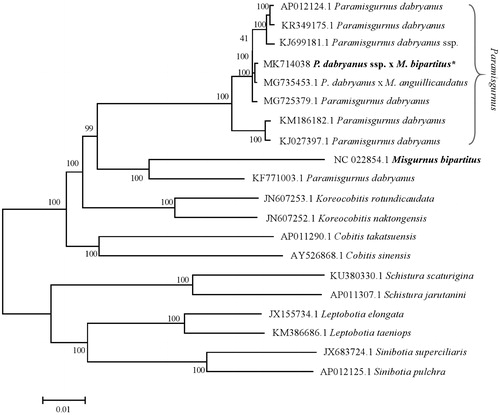Abstract
The hybrid loach of Paramisgurnus dabryanus ssp. (female) and Macropharyngodon bipartitus (male) have the desirable trait of growth performance. There is no report of the complete genome of this hybrid. In this study, the complete mitochondrial genome of this hybrid loach was obtained, and the genome is 16,569 bp in length, including 2 ribosomal RNA genes. 13 proteins-coding genes, 22 transfer RNA genes, and a non-coding control region, the gene composition and order of which was similar to most reported from other vertebrates. Sequence analysis showed that the overall base composition is 29.4% for A, 27.5% for T, 26.4% for C, and 16.7% for G. The sequence is a slight A + T bias of 56.9%. The phylogenetic tree showed the hybrid loach to be one of the Paramisgurnus. Also, the mitochondrial genome sequence of loach were aligned by BLAST, when compared with Cobitinae the sequence similarity could reach >90%, and the similarity to Paramisgurnus was >99%. Mitogenome information from this study could be a useful basis for conservation and phylogenetics of this hybrid loach.
Taiwanese loach (Paramisgurnus dabryanus ssp.) was bred in Formosa and then widely cultivated in China. The Taiwanese loach and Misgurnus bipartitus is a commercially important Cypriniformes fish species in Asia. The hybrid loach of P. dabryanus ssp. (female) and M. bipartitus (male) have the desirable trait of growth performance. Recently, farming scale of the hybrids has been gradually increased in Asia, promising a new variety for loach. There is no report of the complete genome of this hybrid. Therefore, it is very important to characterize the complete mitogenome of this species, which can be utilized in research on taxonomic resolution, population genetic structure and phylogeography, and phylogenetic relationship (Zhang, Wang, et al. Citation2016).
In this study, we sequenced the complete mitogenome of this hybrid with a GenBank accession number MK714038. The voucher specimen was collected from Zhili Fanyi aquaculture base, north latitude 30°22″ and east longitude 120°25″, Huzhou city, China, which were stored in biology herbarium of Heze University. Its tailfins were preserved in 95% alcohol. All DNA were extracted using phenol–chloroform extraction methods and stored at –80 °C (Zhang, Tao, et al. Citation2016). The complete mitochondrial genome sequences were amplified by primers which were initially published for P. dabryanus (Dai et al. Citation2016).
The complete mitochondrial genome was 16,569 bp in length, including 2 ribosomal RNA genes, 13 proteins-coding genes, 22 transfer RNA genes, and a non-coding control region, which was similar to other fishes. The overall base composition was 29.4% for A, 27.5% for T, 26.4% for C, and 16.7% for G. The sequence was a slight A + T bias of 56.9%. Most of the protein genes used ATG as the initiation condons (ND1, ND2, COX2, ATP8, ATP6, COX3, ND3, ND4L, ND4, ND5, Cytb), except for COX1 and ND6 genes, which used GTG and ATA instead of ATG. Eight protein-coding genes ended with complete termination codons, TAA (ND1, ND2, COX1, ATP8, ATP6, ND3, ND4L, and ND5). Gene ND4 used TAG as termination codons, and ND6 use CAT instead of TAA. COX2, COX3, and Cytb share the incomplete stop codon T––. Except for eight tRNA, (tRNASer, tRNAPro, tRNAGlu, tRNATyr, tRNACys, tRNAAsn, tRNAAla, tRNAGln) and the ND6 gene encoded on the L-strand, the other genes were encoded on the H-strand. The 21 kinds of tRNA, tRNALeu, and tRNASer repeated in the complete mitochondrial genome, respectively. This feature is similar to other fish mitochondrial genes. The complete mitgenome sequence had 16s RNA (1678 bp) and 12s RNA (953 bp), which were located between tRNAPhe and tRNALeu(UUR), and were separated by tRNAVal genes. The location is same with most vertebrates that has high conservative. As in most vertebrates, two non-coding regions were found in the hybrid loach mitogenome, the only CR (913 bp) gene located between tRNAPro and tRNAPhe, and an OL (30 bp) was located between tRNAAsn and tRNACys. The 21 tRNA genes, ranging from 66 to 76 bp in size, except for tRNASer(AGY), which lacks a dihydrouridine arm, could be folded into cloverleaf secondary structure. The origin of L-strand was in the WANCY region including five tRNA genes (tRNATrp, tRNAAla, tRNAAsn, tRNACys and tRNATyr) and it can fold into a stem-loop secondary structure with the conserved motif 50-GCCGG-30.
To determine the taxonomic status of the hybrid loach, we performed the phylogenetic relationship of this loach stock with other natural populations in loach as inferred by entire mitogenome (Fan et al. Citation2018). The phylogenetic tree showed the hybrid loach to be one of the Paramisgurnus species (). Also, the mitochondrial genome sequence of loach were aligned by BLAST, when compared with Cobitinae the sequence similarity could reach >90%, and the similarity to Paramisgurnus was >99%.
Figure 1. Phylogenetic relationship of the hybrid loach of P. dabryanus ssp. (female) and M. bipartitus (male) stock with other loach as inferred by entire mitogenome. * The hybrid loach (accession number: MK714038) in the position of the evolutionary tree. Trees were reconstructed using MEGA 7 program (ver. 7.0.26) with the neighbor-joining method. Numbers above branches are bootstrap values by 1000 replicates. The phylogenetic tree showed the hybrid loach to be one of the Paramisgurnus.

Disclosure statement
No potential conflict of interest was reported by the authors.
Additional information
Funding
References
- Dai L, Guo B, Chu Z, Wang Y, Wang X, Huang T. 2016. Complete mitochondrial genome of Paramisgurnus dabryanus. Mitochondrial DNA A. 27:1257–1258.
- Fan L, Tan H, Fazhan H, Xie Z. 2018. The complete mitochondrial genome and phylogenetic analysis of Matuta planipes (Decapoda: Brachyura: Matutidae). Mitochondrial DNA B. 3:157–158.
- Zhang G, Tao P, Chen J, Wang R, Zang X, Yin S. 2016. The complete mitochondrial genome of the hybrid of Pelteobagrus fulvidraco (♀) × Pelteobagrus vachelli (♂). Mitochondrial DNA A. 27:2–5.
- Zhang G, Wang R, Mao J, Yin S, Tao P, Chen J, Yu X, Tang Z, Chen S. 2016. The complete mitochondrial genome and phylogenic analysis of Pseudobagrus vachelli. Mitochondrial DNA A. 27:3551–3355.
